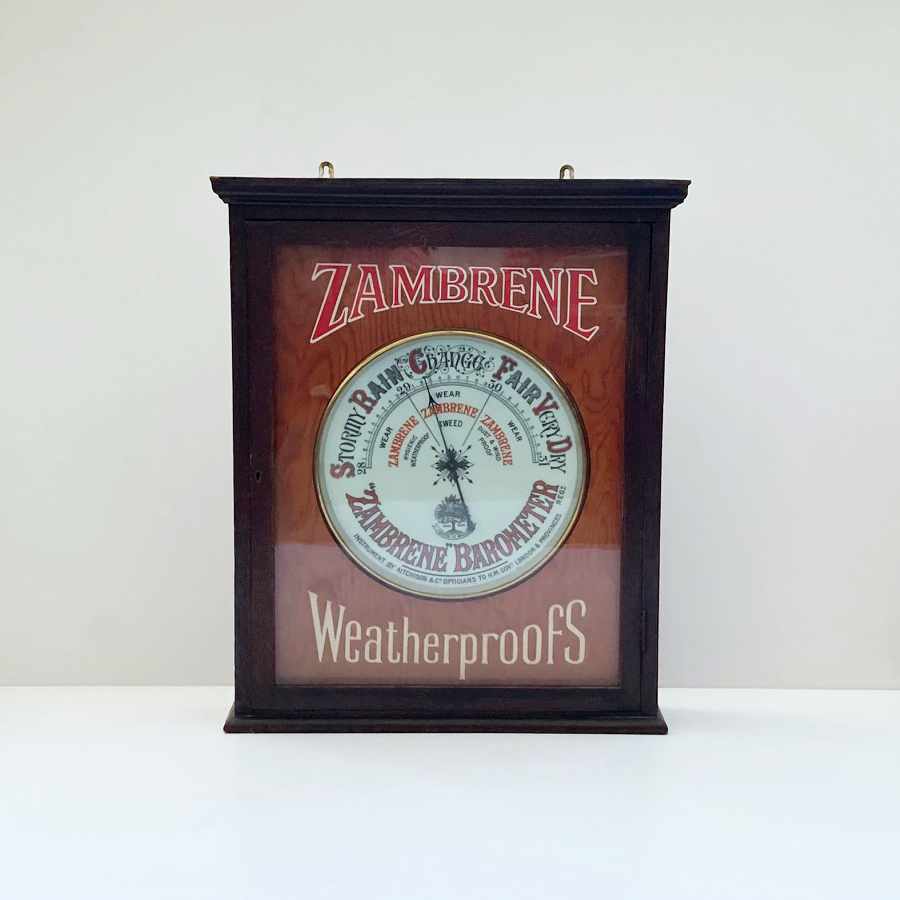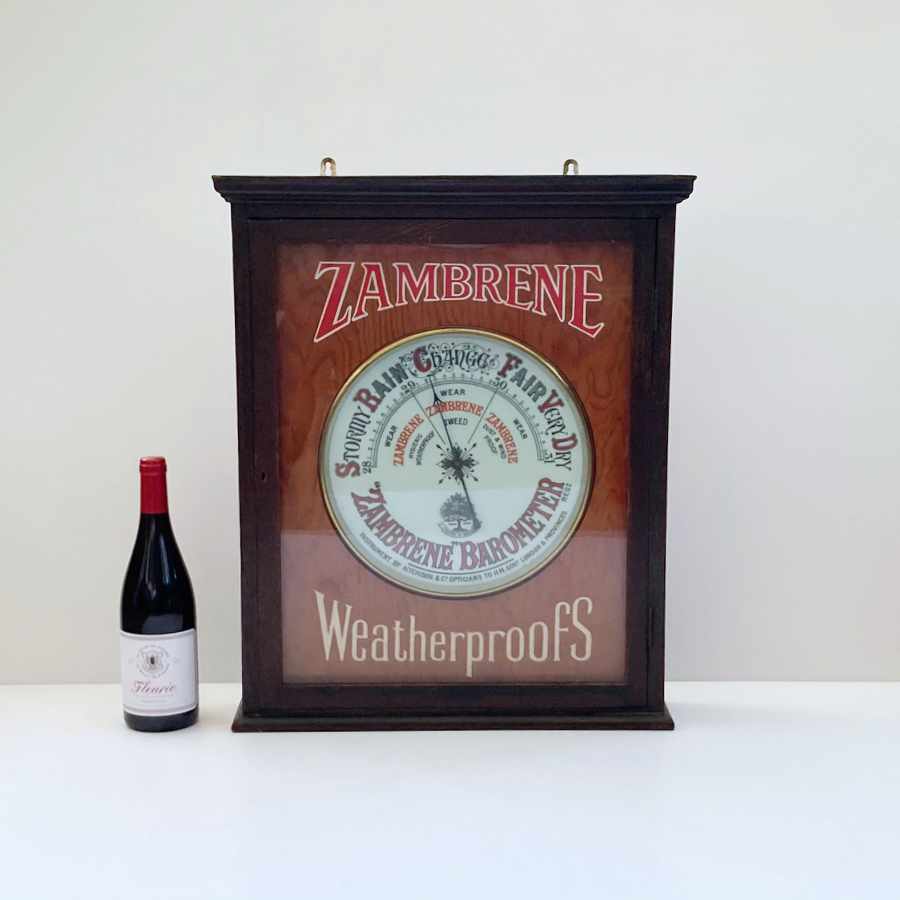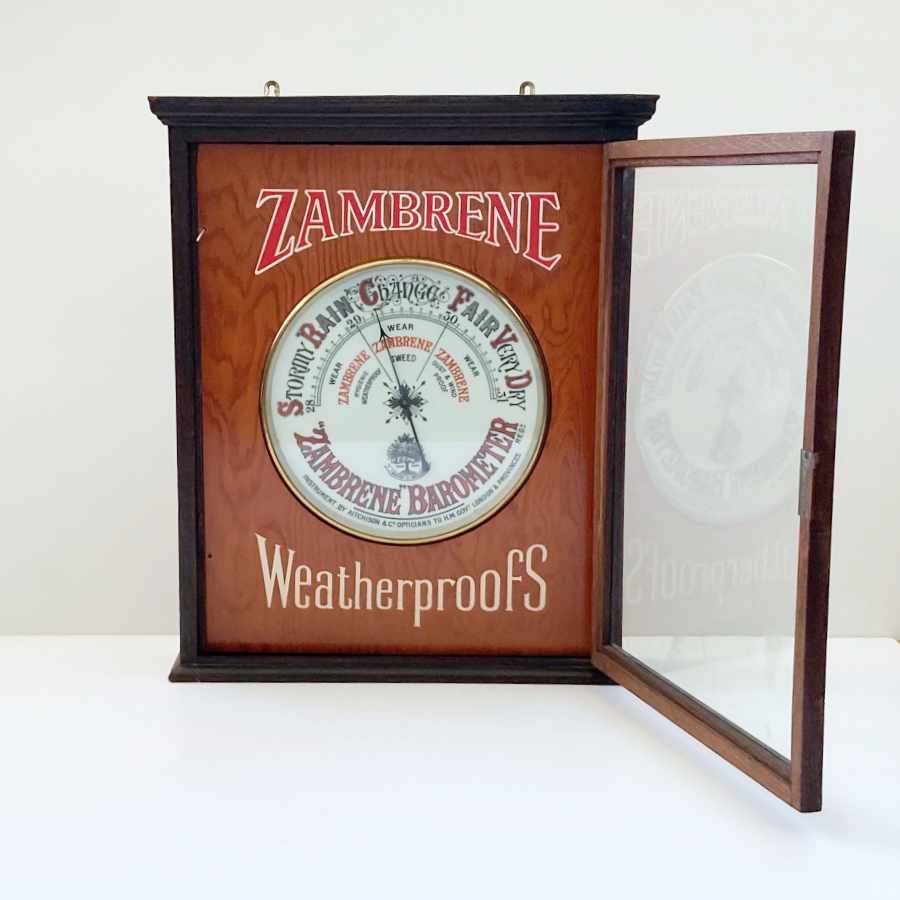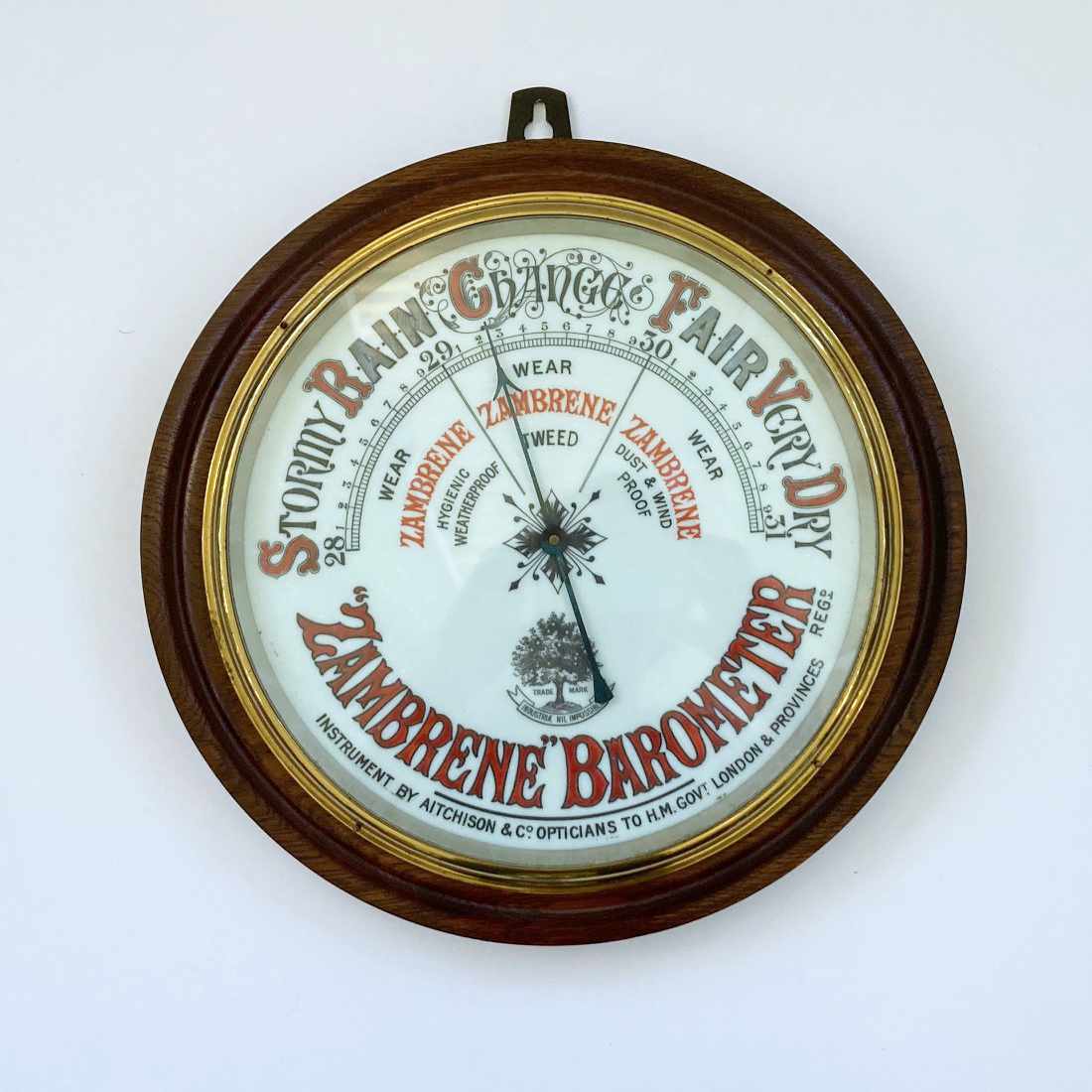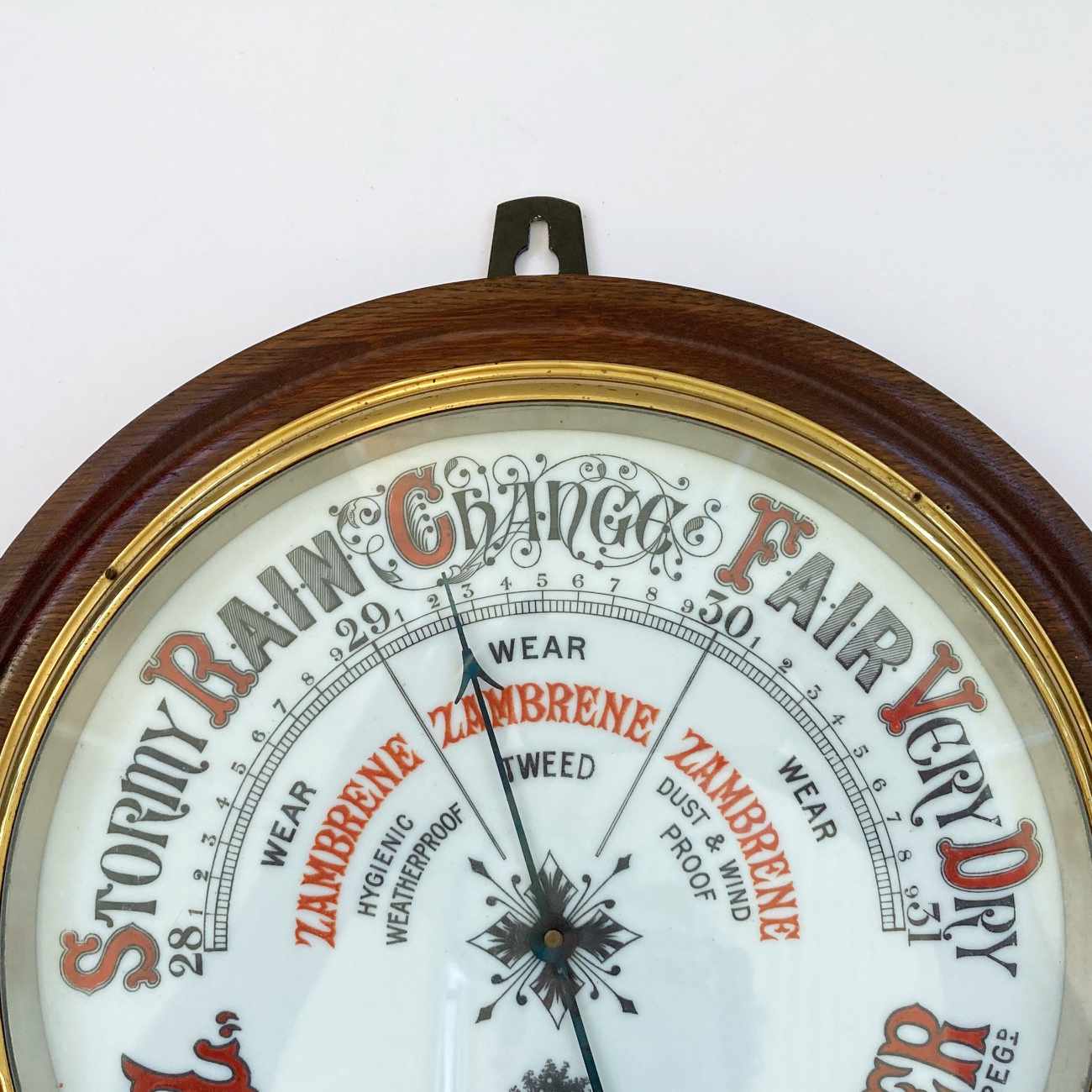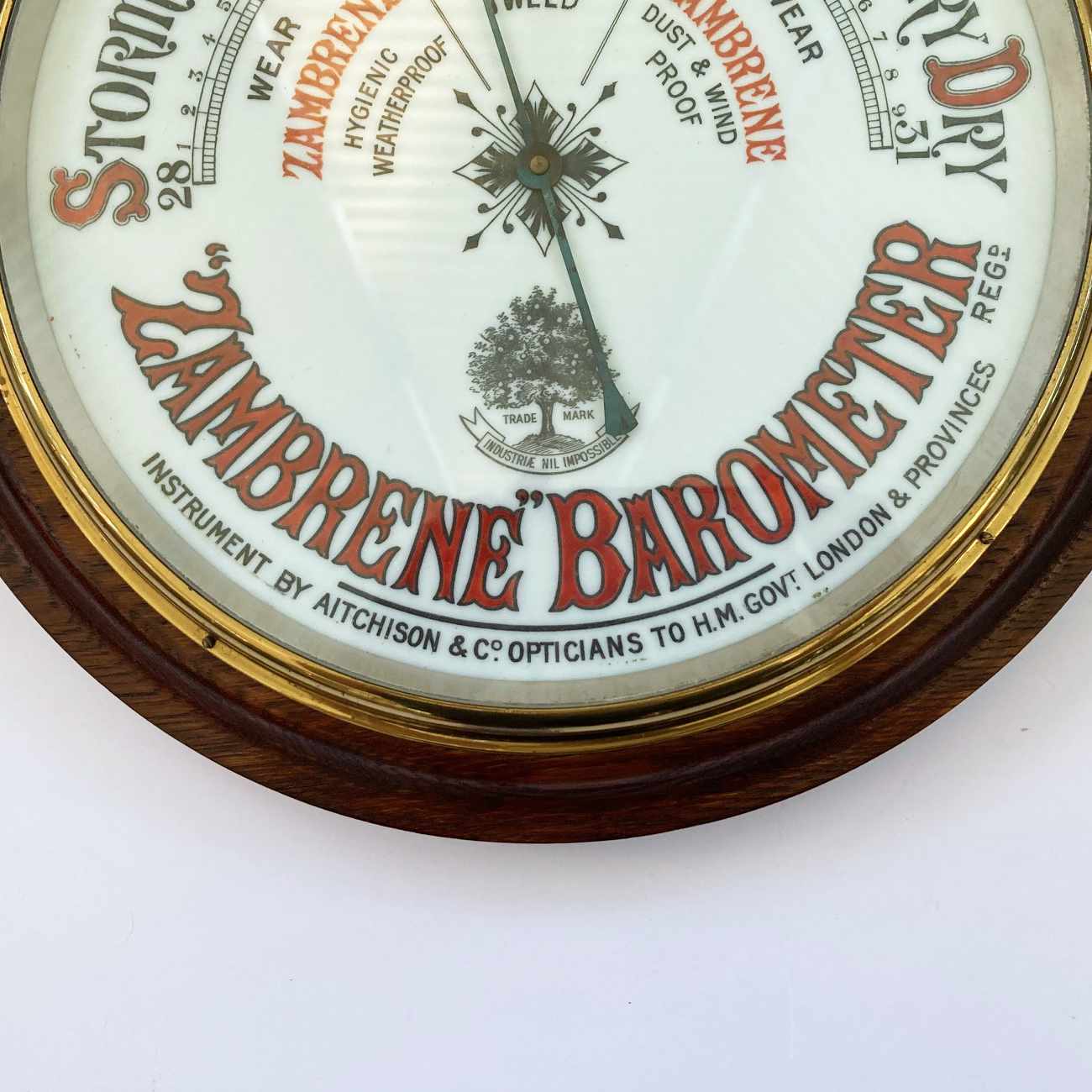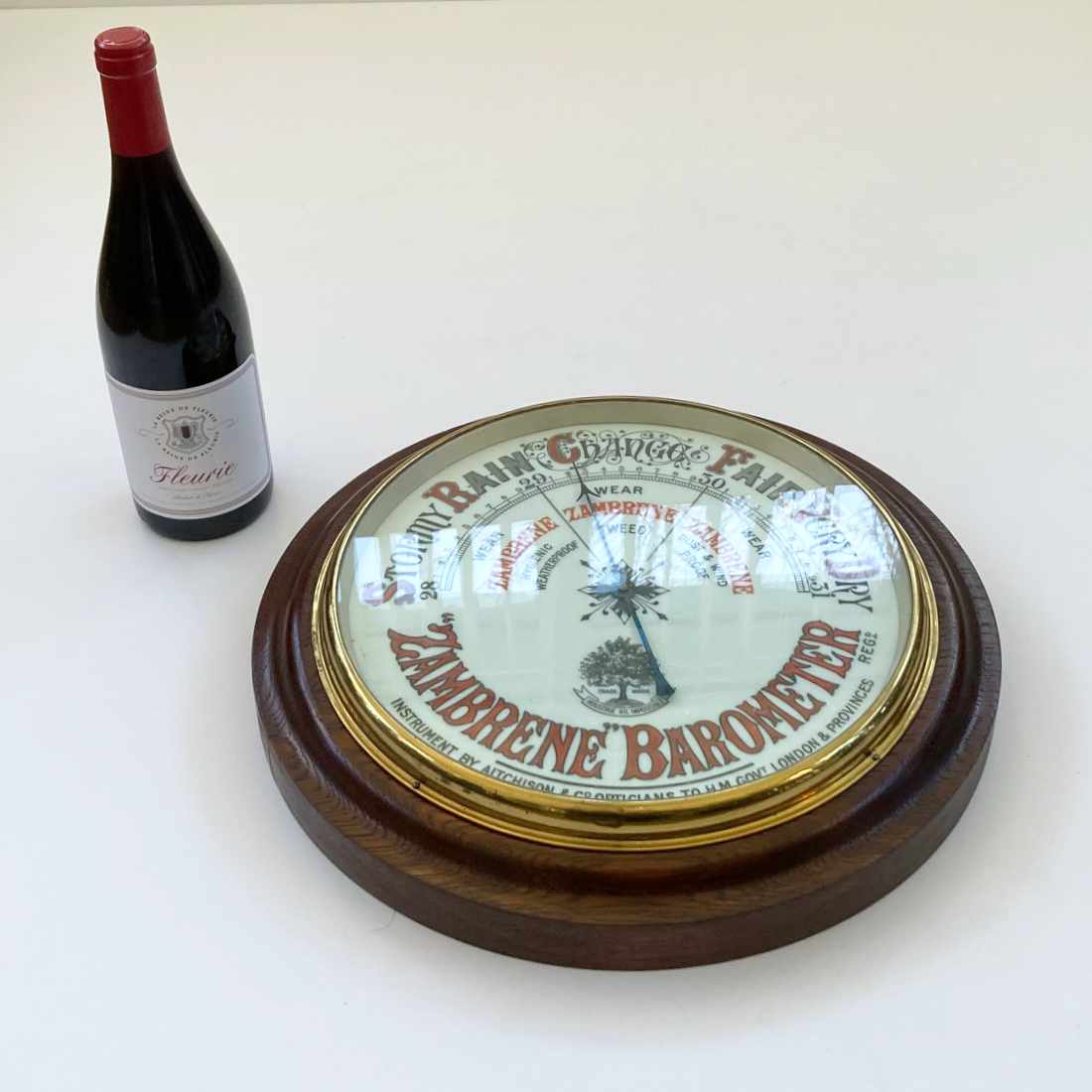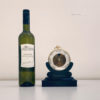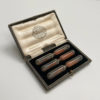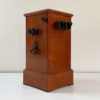Large Shop Display Aneroid Barometer by Aitchison for Zambrene Weatherproof Clothing
£3,000
Large Shop Display Aneroid Barometer by Aitchison for Zambrene Weatherproof Clothing
Dimensions
H: 60 x L: 50 x D: 12cms
Circa
1918
Maker
Aitchison & Co
Country of manufacture
UK and Ireland
Description
For sale a rare and very large shop advertising display aneroid barometer in glazed case for Zambrene Weatherproof clothing.
This unusually large aneroid barometer presents a 12” ceramic sale with a semi-circular scale painted scale displayed around the top half and measuring 28 to 31 inches of barometric pressure. The outer scale is provided with weather indications in decorative Victorian font and accentuated in red, black and grey colours. The inner dial has dividing lines at the 29 and 30 points. The three sections of the dial created are then provided with suggestions of which type of Zambrene clothing product would suit the expected weather associated with the barometer reading. A large blue steel arrowhead pointer marks the current weather.
The lower half is entirely dedicated to the company’s trademark, displaying the words “Zambrene Barometer” in bright red painted lettering, and with the company’s trademark tree emblem and the words “industriae nil impossible” (with industry nothing is impossible).
At the base, in smaller but distinct lettering is the barometer maker’s name, stating “Instrument by Aitchison & Co Opticians to HM Govt London & Provinces”.
The barometer is completed with a simple graduated oak surround and brass spun bezel fitted within a large glazed fronted oak case with hinged door to the front and a short pediment top. Inside is a stained pine surround with central cutaway which covers everything but the barometer dial. The front is sign written to Zambrene Weatherproofs.
An ingenious and clever use of advertising combined to make a very scarce and very pleasing example of its kind. I have seen a few examples of this barometer before but none that retain the original case and insert. This is a rare and complete survivor.
Aitchison’s firm was founded in 1889 at 47 Fleet Street, he undertook his apprenticeship with an optician’s firm in High Holborn before setting up in business initially with Alexander Thomas Clarkson (of Broadhurst Clarkson fame). He is said to have been uncomfortable with the very basic methods that his previous employers used to examine and test patient’s eyes and in a time where glasses were becoming common place across all classes in Britain, he quickly carved himself a niche for supplying very good, high quality lenses at reasonable rates which appealed to the varying pocket sizes providing the public with gold, silver and steel frames for spectacles, lorgnettes, monocles and pince-nez.
Given his reasoning for leaving his previous employment, the subject of standards within the industry continued to be an issue close to Aitchison’s heart, the Worshipful Company of Spectacle Makers was, by then, purely a means of apprenticeship and for gaining practical skills in manufacture rather than for gaining an understanding of the science of optics. They showed little interest when in 1890, Charles Hyatt-Wolf proposed changes to the process which would include examination and certification and having received his re-buff, Wolf sought to organise a separate body to try to tackle the standards of practice. The journal “The Optician” was created in 1891 and in 1895 when Hyatt-Wolf created The British Optical Association (BOA), Aitchison was an enthusiastic founding member and supporter. By this time, he had dissolved his partnership with Clarkson (Gazette 1891) and opened two further branches at 6 Poultry (close to Robert Brettell Bates old premises) and at 428 The Strand. Little is known of Aitchison’s early partnership; Clarkson had owned his own company since 1873 which seems to have remained distinct throughout. As a result, or as a precursor to the decision, Robert Henry Broadhurst joined Clarkson in 1892 and went on to form an equally famous partnership.
The Spectacle Maker’s Company were slow to respond to pressure but in 1898 they began an initial set of examinations which were regarded as unsatisfactory by the BOA and with the efforts to align their activities failing, the BOA brought out its own set of examinations later in the same year. Luckily for the students, the newly built College of Advanced Technology catered for both courses and The Spectacle Makers Company agreed to fund its tutors for the first two years.
Aitchison was amongst the first of The BOA members to undertake its tests but by 1899 had become unimpressed by both The Company and The Association and set out to create The Optical Institute (later, the Optical Society). For this he garnered the support of William Thornthwaite RS and numerous other leading minds.
Aitchison aside from his evangelical approach to the education and qualifications of his industry, was also somewhat evangelical about the effects of poor eyesight on health and along with a shrewd understanding of marketing, he advertised widely, using health benefits as a means of getting the public through the door. The periods of the war from the Boer War to the First World War were also of commercial importance to Aitchison & Co and their Range finding binoculars and “See in the dark glasses” were subject to a huge order from the Imperial Russian Government for use in the Russo-Japanese War. By 1908, the company had added two further London branches at 12 Cheapside and 281 Oxford Street and had opened a regional branch in Leeds. Aitchison had also found the opportunity to write a book on the subject, “Eyesight Preserved – Some Useful hints on the Eyesight”.
It is unsurprising given the above that James Aitchison’s life did not continue into contented old age, he died suddenly in 1911 at the age of 51 by which time he had been central to both the reformation of the optical industry’s educational programmes and also to the popularising and naturalising of spectacle wearing across Britain by his widespread (and sometimes criticised) use of advertising.
The demise of Aitchison at such a young age left his son Irvine, a 23-year-old law student heading up a large company, however he had enough foresight to employ his father’s friend and business partner, Arthur Bernard Clark to be joint Managing-Director. The impending war years were to have a devastating effect on the optical industry due to the huge reliance it had on the German lens manufacturers in Jena but through its sales to the War Office and its reputation, the company managed to persevere. Their branches also contained stocks of barometers, thermometers, pedometers, map measurers, microscopes, linen provers and damp protectors to bolster sales. Sadly, their soon to be partner Dollond was not coping quite as well, their reputation was still renowned but through lack of good accounting practices and bad organisation, they were close to failure. In 1925, exploratory conversations began between Dollond and Aitchison and finally on the 31st of August 1927, Aitchison finally acquired the goodwill, stock and leases of Dollond & Co and the new company of Dollond & Aitchison was created.
Irvine Aitchison continued to run the business until his death in 1965 and since his son Peter had died in 1947 whilst taking part in the notorious Isle of Man TT race, the company continued thereafter without a family connection to either the Dollond or Aitchison families. It continued to prosper however and was a recognisable feature across many British High Streets until 2009 when it was finally bought out by Boots the Opticians.
The trademark Zambrene product was created by the company of B. Birnbaum & Son who (unsurprisingly given the subject of the advertising), manufactured weatherproof material finished into numerous different forms of clothing. They produced rubberised clothing (Reinbo & Bee-Bee trademarks) and Zambrene as a “rubberless” alternative. Evidently successful, the company attended numerous exhibitions during the late Nineteenth and early Twentieth Century and had manufacturing bases in New York, Melbourne and Head Office and rubber works in London.
Their rise to popularity seems to have aligned very well with Aitchison and it is likely that the companies formed some business relationship through the exhibition circuit or indeed through the association of their products with military use. Zambrene advertised heavily during the War years with imagery of soldiers using their products on the front lines. Little detail remains of the company’s history but extant advertising confirms that they were still trading during the 1930’s. It seems obvious though that their popularity was at its height during the first two decades of the Century.
This example can be dated to between 1908 & 1927, the former because the “provinces” are mentioned on the barometer dial, a nod to the Aitchison branch which began trading in Leeds from this time and the latter being the date when the company changed to Dollond & Aitchison. The date range would also fit precisely with the period of popularity for Zambrene clothing.
The case measures: 60 x 50 x 21cms
Circa 1918



